Paul Gilster's Blog, page 211
December 30, 2013
Laser Communications for Deep Space
A recent email from Centauri Dreams regular Carl Keller reminded me about the laser communications tests conducted aboard a NASA satellite. The Lunar Atmosphere and Dust Environment Explorer satellite (LADEE) carried a laser package that demonstrated excellent download and upload rates and successful transmission of two simultaneous channels carrying high-definition video streams to and from the Moon. The fast transmission of large data files shows how useful laser methods will become.
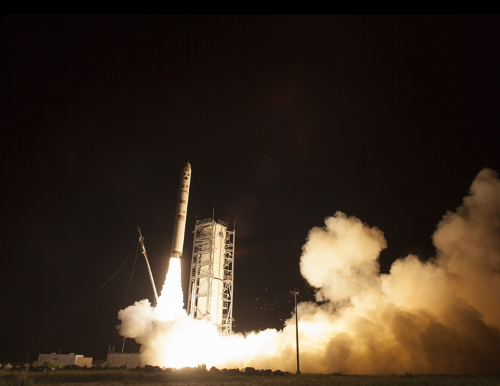
Image: NASA’s Lunar Atmosphere and Dust Environment Explorer (LADEE) observatory launches aboard the Minotaur V rocket from the Mid-Atlantic Regional Spaceport (MARS) at NASA’s Wallops Flight Facility, Friday, Sept. 6, 2013, in Virginia. Image Credit: NASA/Clara Cioffi.
All this is heartening because we need better communications as we begin to build a true infrastructure in the Solar System, while the demands of interstellar communication we’ll eventually need for probes of other stars are even more immense. The easy comparison is sitting right on our desktops in the form of the PCs we use everyday to communicate with the Net. Cable connections make website loading relatively painless, but most of us remember the frustration of early graphics coming in over painfully slow modem connections. Can lasers put the same kind of zip into communications from spacecraft at the edge of the Solar System?
Let’s hope so. I’m remembering the overloads that plague the Deep Space Network, extending decades back. In 1993, the Galileo spacecraft had a chance to take a close look at the asteroid 243 Ida, well worth viewing because the cratered rock was orbited by a ‘moon’. But the DSN also had to handle the load from controllers trying to revive the Mars Observer probe, so that important traffic that would have supported Galileo’s asteroid flyby was diverted. Galileo snapped a photo of Ida anyway, but the problem of overcrowded resources has only gotten worse.
In any case, when we’re talking truly long-distance communications, we have to reckon with the fact that our radio signals drop in intensity with the square of their distance, so a spacecraft ten times farther out than its twin sends a signal that’s fully one hundred times weaker. The numbers on actual missions staggered me when I first ran into them: The signal received from Voyager’s 23 watts was twenty billion times weaker than the power needed to operate a digital wristwatch when the Neptune encounter occurred back in 1989. Put that same signal around Alpha Centauri and it would arrive 81 million times weaker still, as I learned from James Lesh at JPL.
No wonder early starship designers leaned on massive dishes — consider the 40-meter second stage engine bell which, when burned out, the Daedalus craft would employ as a massive communications dish. And in order to process the signals from the starship, the British Interplanetary Society team assumed an Earth-based asset called Project Cyclops, one that would have been armed with a thousand 64-meter antennae. Like Robert Forward, the Daedalus designers as well as the SETI community was thinking big back in the 1970s.

Image: What might have been. The gigantic Cyclops antenna array as envisioned in the 1970s. Credit: Columbus Optical SETI Observatory.
But Daedalus also was conceived as having laser capability that would be used while the craft was under power, and so was the US Navy student project called Project Longshot, which the class that came up with it equipped with six 250-kilowatt lasers, three for communications during the acceleration of the vehicle, and three for communications as Longshot arrived in the Alpha Centauri system. Lasers change the dynamic, but the point is we’re only now testing out the systems that will eventually make them commonplace in space communications.
Radio beams, after all, spread out at a diffraction rate determined by the wavelength of the signal divided by the diameter of the antenna. When we start pushing into higher and higher frequencies, the resulting signal becomes much more narrow. The advantages in reducing spectrum-crowding are supplemented by the laser signal’s ability to carry much more data, as the recent tests aboard LADEE demonstrate. Moreover, the optical telescopes needed aboard a spacecraft can be significantly smaller than the large radio dishes in use today.
Extend all those ideas into the far future and you wind up with an optical installation about the size of the Hubble Space Telescope capable of beaming useful data back to Earth from Alpha Centauri. That’s the 20-watt laser signal that would be beamed back to space-based telescopes in the Solar System, according to JPL’s Lesh in a well-known paper in JBIS. Remember that Voyager signal — it’s now puffed up to well over a thousand times the diameter of the Earth because of beam diffraction. The tight beam of the Centauri laser would get the message through. Of course, a way to propel a communications system as big as Hubble to another star has to be discovered first.
Can we get around all this with gravitational lensing and much smaller equipment? Conceivably, and I’ll have some interesting news about Claudio Maccone’s FOCAL mission to the Sun’s gravitational lens in the next few weeks. I also want to talk a bit more about the LADEE experiments. I’ve mentioned the Lesh paper in these pages before, but here’s the reference again: Lesh, C. J. Ruggier, and R. J. Cesarone, “Space Communications Technologies for Interstellar Missions,” Journal of the British Interplanetary Society 49 (1996): 7–14.






December 27, 2013
Pondering Recent Exomoon News
‘Exomoons’ — moons around planets around other stars — are another of those new frontiers of modern astronomy. It’s astonishing to reflect that 51 Pegasi b, the first exoplanet orbiting a main-sequence star, was discovered as recently as 1995, a time when we could only suspect that planets might be common and were only then working out the best ways to find them. Now we have thousands of planet candidates, the search is on for true Earth analogues, and the idea that we might make as fine-grained a discovery as an exomoon is an exhilarating prospect.
So is the recent paper from David Bennett (University of Notre Dame) and colleagues the breakthrough we’ve been waiting for? The answer is no because we have no way of knowing whether this suggestive find is a true moon around a planet or perhaps two larger objects in gravitational synch at a much further distance. But either case is intriguing. Here are the possibilities for the 2011 event called MOA-2011-BLG-262, detected by gravitational microlensing:
A gas giant of three to four times Jupiter’s mass at a distance of 1800 light years, the moon being, at about half the mass of Earth, absolutely gigantic in comparison to moons in our Solar System and orbiting its host world at a distance of 0.13 AU, quite a large separation. This is what Bennett and team call the ‘fast model,’ ; or
A much more distant brown dwarf orbited by a Neptune-mass planet. This is the ‘slow model’ (see the paper for details on the use of these terms).
Now brown dwarfs with planets are interesting enough, so I would find either of these scenarios fascinating. But what makes the exomoon picture still more riveting is that these objects are evidently out there on their own, with no associated star. If we really are looking at an exomoon and a planet, then the question of how they came to be where they are emerges. New Scientist quotes exomoon hunter David Kipping (Harvard University) as saying “It almost begs the question as to whether we can really call these objects ‘moons’ or whether some other name is more apt.” What that other name might be is left to the imagination of the reader.
So unusual would a free-floating planet with a moon of its own be that the paper on this work leans preferentially to the brown dwarf solution. From the preprint:
…an apparently free-floating planet with a half Earth-mass moon would be a new class of system that was not previously known to exist. Such a new discovery would require strong evidence, so our favored model for this event is that it is a low-mass star or brown dwarf orbited by a planet of about Neptune’s mass.
Or as the abstract puts it: “The data are well fit by this exomoon model, but an alternate star+planet model fits the data almost as well.”
If that seems to take the sizzle out of this story, please reconsider. This interesting duo was identified by gravitational microlensing, in which the passage of an object in front of a more distant star bends the light from that star in ways that can be quantified. In the case of MOA-2011-BLG-262, the light of the distant star was magnified about seventy times beyond the norm. About an hour later the second, smaller increase in brightness occurred, suggesting the passage of two objects in front of the star. Because microlensing events don’t repeat, we may never be able to untangle the true story of MOA-2011-BLG-262. But the work of Bennett and colleagues points to future microlensing breakthroughs:
…it should be possible to definitely distinguish similar models for future events if they are observed with high cadence from multiple sites. Very high cadence observations on 1-2m class telescopes are able to measure the light curves precisely enough to distinguish similar models (Gould et al. 2006), such as the fast and slow models for MOA-2011-BLG-262. If these high cadence observations are taken from observatories separated by thousands of kilometers, then the terrestrial parallax effect can be used to measure the lens masses (Gould & Yee 2013).
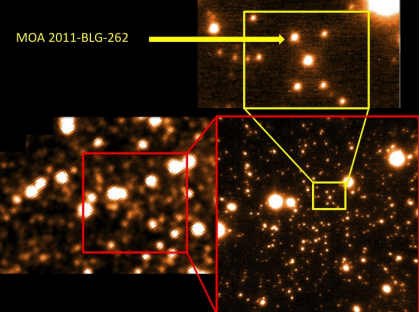
Image: The left panel shows a K-band (infrared) image from the VISTA 4m telescope from the VVV (Vista Variables in the Via Lactea) survey. The field observed by the Keck-2 telescope in K and a zoom of this field are shown to the right. The arrow indicates the microlensing source star, separated by 0.51 arcsec from its nearest neighbor. Credit: David Bennett.
‘Cadence’ as used in the passage above refers to how long it takes to re-observe the same target. High cadence can be combined with other techniques, and the paper notes that observatories separated by thousands of kilometers can take advantage of terrestrial parallax to increase and refine the microlensing detection rate. Ultimately, we’ll need new instruments:
…the development of large robotic networks of 1m class telescopes, such as the Las Cumbres Robotic Telescope Network (Brown et al. 2013), will substantially improve the rate of terrestrial microlensing parallax mass measurements. Thus, if systems resembling the planetary-mass host models for MOA-2011-BLG-262 are common, the combination of high cadence microlensing surveys, rapid realtime event detection by these surveys, and high cadence follow-up observations should enable the definitive discovery of rogue exoplanets with moons of nearly an Earth mass within a few years.
Recall the ground-breaking work of David Kipping and colleagues on using transit timing (TTV) and transit duration variations (TDV) to spot an exomoon signal in transit data, and the ongoing Hunt for Exomoons with Kepler project that Kipping runs. Add in this recent microlensing story and the possibility of future microlensing discoveries of the kind described above. It’s clear that we have exmoon detections in our future, and who knows what we may learn about the characteristics of rogue objects that, if MOA-2011-BLG-262 is a true indication, may not be traveling alone.
The paper is Bennett et al., “A Sub-Earth-Mass Moon Orbiting a Gas Giant Primary or a High Velocity Planetary System in the Galactic Bulge” (preprint).






December 24, 2013
Mass Effect: What Exoplanet Atmospheres Can Tell Us
Let me offer best wishes for the holidays to all Centauri Dreams readers, with thanks for the numerous comments and suggestions over the course of the past year. The schedule this week is abbreviated but I’ll have a new post up on Friday. I’m about to set out to gather the materials I need for a family dinner tonight, but I have time this morning to talk about interesting new work on figuring out the mass of an exoplanet. As you might guess, this is a key measurement, and a tough one to make. The work out of MIT offers an elegant solution.
I yield to no one in my admiration for the tough-minded Sara Seager (MIT), whose career in astrophysics is so movingly described in Lee Billings Five Billion Years of Solitude. A number of readers pointed out Seager’s most recent study, which develops this new technique for our exoplanet toolkit. Julien de Wit, a MIT grad student who is lead author on the paper just published in Science, describes his work with Seager as a way of determining the mass of an exoplanet using nothing more than the signature of its transit.
Now this is interesting stuff because learning something of a planet’s mass can help us make the call on whether it is a rocky world capable of supporting life. Radial velocity methods work well when larger planets are at play, or smaller worlds that orbit extremely close to their parent star. But radial velocity is trickier when we’re dealing with small planets orbiting further out. A planet like the Earth, for example, would be hard to analyze using radial velocity alone. We do, however, have the ability to study planetary atmospheres as planets transit their stars, and ingenious analysis may make it possible to extract from this a reading of a planet’s mass.
Thus de Wit’s description of what the duo have been up to:
“With this method, we realized the planetary mass — a key parameter that, if missing, could have prevented us from assessing the habitability of the first potentially habitable Earth-sized planet in the next decade — will actually be accessible, together with its atmospheric properties.”
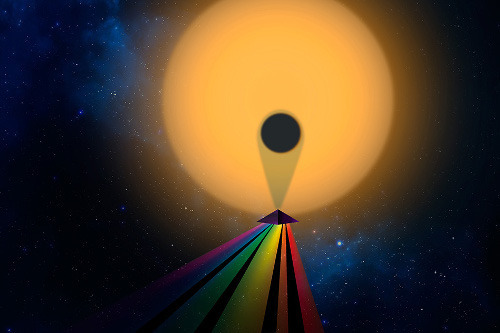
Image: Artistic rendering of a planet’s transmission spectrum. Credit: MIT.
How? Our old friend HD 189733b comes into play, a transiting ‘hot Jupiter’ some 63 light years away that has been a testbed for the technique called transmission spectroscopy, where scientists analyze the light that passes through the atmosphere to determine properties like temperature and the density of atmospheric molecules. Because we can study an atmosphere, we can study the effect of mass on that atmosphere. The method described in the de Wit/Seager paper works with a standard equation that describes the effect of three factors — temperature, gravitational force and atmospheric density — on the planet’s atmospheric pressure profile, which is a measure of how pressure changes throughout the atmosphere.
Believing that each of these factors could be derived independently from a transmission spectrum, de Wit studied the effects of each using the 18th Century mathematical constant called the Euler-Mascheroni constant. This MIT news release describes the constant as an ‘encryption key’ that helped decode the ways the properties of a planet’s atmosphere are embedded in its transmission spectrum. Turned on HD 189733b, the analysis yielded the same mass measurement that other scientists had obtained by radial velocity methods. Future space-based platforms should be able to turn these methods to much smaller worlds.
My particular interest in red dwarfs is piqued by this study, because radial velocity methods are not well suited for small planets orbiting faint stars. Extending the range of mass measurement through this new transit technique would make the mass of planets transiting red dwarfs that much more discoverable, offering another way of characterizing possibly habitable worlds. The technique is not, of course, limited to red dwarfs, and we can assume that Earth-sized planets orbiting stars not so different from the Sun will be studied using the same methods, once we have space-based instruments like the James Webb Space Telescope operational.
The paper is de Wit and Seager, “Constraining Exoplanet Mass from Transmission Spectroscopy,” Science 20 December 2013 (abstract).






December 23, 2013
From Brown Dwarfs to NEOWISE
I will admit to an obsession with small, dim stars, one that goes far enough to take in those not-quite stars called brown dwarfs, objects too small to ignite hydrogen fusion. The WISE mission showed us that, at least in our Sun’s neighborhood, brown dwarfs aren’t as common as we once thought, with perhaps one of them for every six main sequence stars. For their part, red dwarfs are the prime currency of the galaxy, accounting for 75 to 80 percent of all stars, so between the two we have a host of venues for planets and, possibly, life. But so much needs to be done before we’ll know if either brown or red dwarfs could really be candidates for astrobiology around them.
These thoughts are triggered by more news from WISE, now in its reactivated incarnation as NEOWISE (Near-Earth Object Wide-field Infrared Survey Explorer). The spacecraft came back to life in September after 31 months of hibernation and is now working to help us identify potentially hazardous near-Earth objects, a reminder that brown dwarfs were only a part of a much larger mission to characterize the infrared sky. But before I leave brown dwarfs today, let me run an image Greg Benford passed along, a Jon Lomberg conception of a brown dwarf.
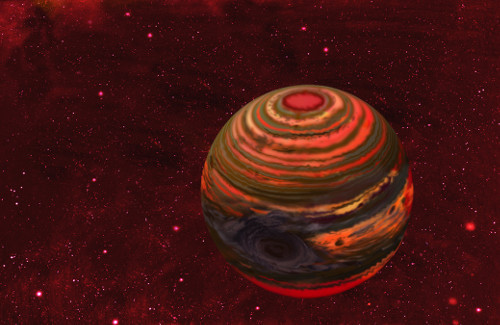
Image: Could a brown dwarf like this form planets that support life? Credit: Jon Lomberg.
If memory serves, I ran this image a long time ago in the course of another brown dwarf discussion, and Greg and I talked about it at the first 100 Year Starship Symposium in Orlando. The Lomberg artwork was on Greg’s mind when he finished his recent story “The Man Who Sold the Stars” (in Starship Century) with a scene set around a dim brown dwarf that was only discovered after a renewed search of old data, including that of the WISE mission. Greg describes a surreal landscape on a planet orbiting the brown dwarf called Redstar:
Stars shone in pale gray here against the inky black. The huge hull of Redstar hung as a burgundy disk cut off by the sea. Here and there across the long panorama of perpetual twilight, slanting rays of a deep Indian red showed floating plants, lapping on the waves in a somber sprawl. Everything glowed with infernal incandescence…. Down from the desolate slope to his left came an echoing cry, long and slow. In the thick air a thing like a huge orange gossamer butterfly fluttered on a thin wind. It swooped across a sky peppered with amber clouds and vanished with deliberate, long flaps of its enormous wings, vanishing behind a low eroded hill.
As we learn more about dim stars and much dimmer brown dwarfs, we have to answer key questions that impinge upon their chances for such life. About red dwarfs, we have to learn whether tidal lock offers stable meteorology anywhere on the surface (various papers have argued that it can), and whether the flare activity particularly in young stars would sterilize the planet or serve as a spur to evolutionary change. About brown dwarfs we have to learn whether these continually cooling objects produce rocky planets in close orbits that could stay warm long enough for life to thrive.
NEOWISE Surveys the Nearby Sky
We won’t have the answers to these questions any time soon. For this morning, then, back to NEOWISE. The image below shows a view from the spacecraft after its recent reactivation. If you’ll study the center of the image, you’ll see the track of an asteroid as captured in a series of exposures. This image shows an area in the constellation Pisces; the asteroid is (872) Holda. A red streak at the top of the image is the track of an Earth-orbiting satellite.
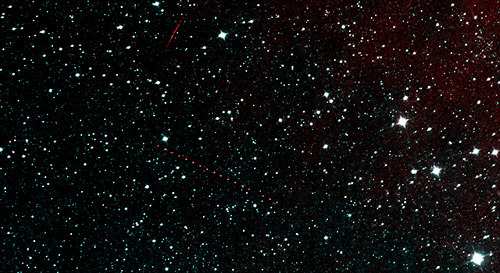
Image: NEOWISE originated as WISE (Wide-field Infrared Survey Explorer), which was put into hibernation in 2011 upon completing its goal of surveying the entire sky in infrared light. WISE cataloged three quarters of a billion objects, including asteroids, stars and galaxies. In August 2013, NASA decided to reinstate the spacecraft on a mission to find and characterize more asteroids. Credit: NASA/JPL.
From 2010 to early 2011, NEOWISE discovered more than 34,000 asteroids and characterized 158,000 throughout the Solar System. Amy Mainzer, principal investigator for NEOWISE at JPL, looks at the future of the mission:
“NEOWISE not only gives us a better understanding of the asteroids and comets we study directly, but it will help us refine our concepts and mission operation plans for future, space-based near-Earth object cataloging missions. The spacecraft is in excellent health, and the new images look just as good as they were before hibernation. Over the next weeks and months we will be gearing up our ground-based data processing and expect to get back into the asteroid hunting business, and acquire our first previously undiscovered space rock, in the next few months.”
NEOWISE uses a 40-centimeter telescope and infrared cameras in going about its work studying asteroid size, albedo, reflectivity and other properties. The original WISE mission captured more than 2.7 million images in various infrared wavelengths and catalogued well over 700 million objects. The primary goal of NEOWISE is to study asteroids and comets that approach within 45 million kilometers. It’s exciting and necessary work, but I do wish we had a second WISE working on brown dwarfs.






December 20, 2013
Cometary Clues to the Fomalhaut System?
It was only in October of this year that we discovered that a red dwarf star called LP 876-10 was in fact part of the Fomalhaut system. Now known as Fomalhaut C, the diminutive object is making news of its own with the announcement that, like its much larger and brighter counterpart, Fomalhaut A, it hosts a belt of comets. That two stars in the same system could each have a ring of comets raises interesting issues. Grant Kennedy (University of Cambridge), whose team made the discovery using data from the Herschel Space Observatory, explains:
“It’s very rare to find two comet belts in one system, and with the two stars 2.5 light years apart this is one of the most widely separated star systems we know of. It made us wonder why both Fomalhaut A and C have comet belts, and whether the belts are related in some way.”
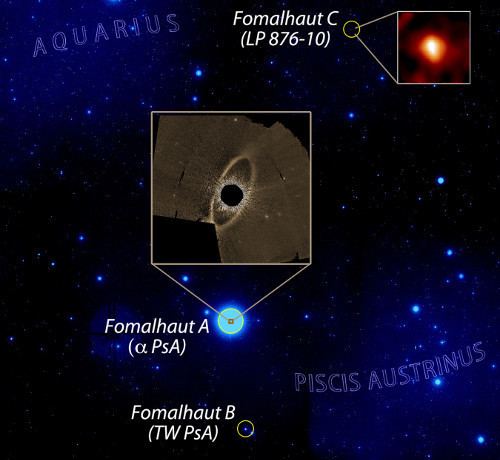
Image: View of the Fomalhaut triple star system from Earth. The small inset shows a zoom of the newly discovered comet belt around Fomalhaut C as seen at infrared wavelengths by Herschel. The large inset shows a zoom of the much larger comet ring around Fomalhaut A as seen at optical wavelengths by Hubble. Telescope resolving power is lower at the infrared wavelengths observed by Herschel, so the size of the belt around Fomalhaut C is not well known. Image Credit: Grant Kennedy (Cambridge) & Paul Kalas (UC Berkeley).
There are those who speculate that the Oort Cloud might extend halfway to Alpha Centauri, perhaps intersecting with a similar cloud around the triple star system there, but the idea that stars 2.5 light years apart could be members of the same system takes a little getting used to. Proxima Centauri, at some 15000 (plus or minus 700 AU) has undergone extensive scrutiny to discover whether it is gravitationally bound to Centauri A and B — Greg Laughlin and Jeremy Wertheimer (UC-Santa Cruz) make a convincing case that it is. 2.5 light years is a much further stretch, but Fomalhaut C has been demonstrated to be gravitationally bound to Fomalhaut A.
And in case you’re wondering, Fomalhaut B (TW PsA), the second member of this trinary system, is fully 0.91 light years from Fomalhaut itself, a K4-class object whose velocity and age are consistent with its being bound to this system. You’ll recall that Fomalhaut A is also where the first planet to be directly imaged at visible wavelengths was found. The image of Fomalhaut b showed it to be orbiting just inside the outermost of the star’s two debris disks, perhaps as much an accumulation of rubble as a fully-formed planet, but one capable of shaping the debris disk itself. The disk emits considerable infrared radiation and has been well studied.
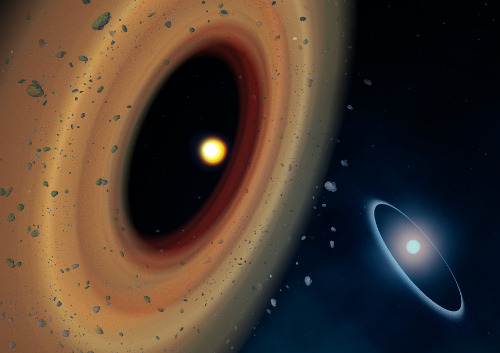
Image: Artist’s impression of the Fomalhaut system. The newly discovered comet belt around Fomalhaut C is shown to the left. The comet belt around Fomalhaut A is in the distance to the right. The belt around Fomalhaut A is offset slightly, a signature of the elliptical orbits in the belt, which may have been caused by past interactions with the star Fomalhaut C. Credit: Amanda Smith.
The discovery of a cometary belt around Fomalhaut C may be telling us something about encounters within this system in the past. For both the outermost disk around Fomalhaut A and the planet that orbits it move in elliptical orbits, probably the result of encounters with undetected planets or with one of the other two stars, B and C. Encounters like these can brighten a disk by causing the comets within them to collide more frequently and release more dust and ice. The comet belts around both A and C in the Fomalhaut system are bright enough to suggest such encounters. To follow up on the matter will require further study of Fomalhaut’s C’s orbit.
The paper summarizes the situation:
Whether there is any link between the discs around Fomalhaut and LP 876-10 is unclear. If the stars have always remained well separated, the evolution of the two bright debris discs should be no different to random single stars, and their detection in the Fomalhaut system would be attributed to the relative youth of the system (in particular LP 876-10). Alternatively, the wide separation of the companions may lead to complex dynamics; the bright debris discs and eccentric planet may have a common cause due to a past interaction between Fomalhaut and LP 876-10, which stirred up their debris discs, perhap igniting a collisional cascade in a previously quiescent disc… or provoking an instability in the planetary system… that later stirs the disc. Such scenarios are of course speculation, but motivate detailed descriptions of all system components.”
All of which gets us back to Fomalhaut B, a star that lacks a bright debris disk of the sort found around its two companions. Is the very lack of such a disk pointing to past encounters between A and C, with B unaffected by their interactions? Computer simulations and further observations of the Fomalhaut C belt may provide some answers. The paper adds: “At only a few dozen light years from Earth, this remarkable system provides a unique laboratory in which to observe one outcome of star and planet formation in detail.”
The paper is Kennedy et al., “Discovery of the Fomalhaut C debris disc,” published online in Monthly Notices of the Royal Astronomical Society Letters, 17 December 2013 (abstract / preprint).






December 19, 2013
Possible Planet in Nearby Brown Dwarf System
Has astrometry finally bagged an exoplanet? A new study from Henri Boffin (European Southern Observatory) and colleagues has found compelling evidence that the nearest pair of brown dwarfs to the Sun — WISE J104915.57-531906, otherwise known as Luhman 16AB — is home to a hitherto undetected companion. It’s interesting news not only for the astrometry angle but because Luhman 16AB is no more than 6.6 light years away, making it the third closest system to the Sun after Alpha Centauri and Barnard’s Star.
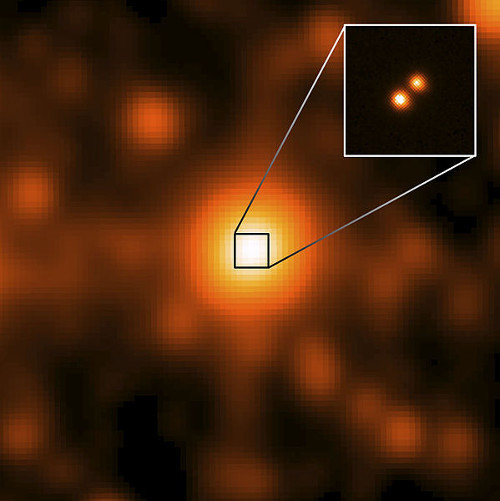
Image: Luhman 16AB, two brown dwarfs in the Sun’s neighborhood, now considered home to a possible planet. Credit: NASA / JPL / Gemini Observatory / AURA / NSF.
I give prominence to astrometry here because the European Space Agency’s Gaia mission was launched this morning, chartered with creating a three-dimensional map of the Milky Way, but also with finding exoplanets using astrometry as its primary method. While radial velocity measures tiny motion in stars induced by unseen planets, it does so by analysis of the Doppler shift in light from the star. Astrometry actually measures the positions and movement of the stars. It’s all about measuring angles and deriving astrophysical data from the result.
The Hubble Space Telescope used astrometric methods in 2002 to study a planet around Gliese 876 that had already been discovered, but despite many claims, planet discoveries via astrometry have yet to be confirmed. The technique has had a checkered history. William Herschel studied the effects of what he believed to be an unseen companion on the star 70 Ophiuchi in the 18th Century, and numerous claims involving other nearby systems have been made over the years, most recently one involving a Jupiter-class object around the nearby red dwarf VB 10 and a 2010 study of HD 176051. But the changes in stellar position involved are so tiny that we need a new generation of instruments to really put the method to work.
The late, lamented Space Interferometry Mission would have been such an instrument, but of course it never flew. Now we have Gaia to look forward to, and as the mission progresses, we’ll follow its observations with interest. The sunshield has deployed and Gaia is moving toward L2, some 1.5 million kilometres beyond Earth as seen from the Sun. Gaia will measure stars with micro-arcsecond precision. Astrometry is most sensitive to planets with large orbits, which makes it a useful complement to radial velocity methods that are most sensitive to nearer objects.
For our purposes today, though, the Boffin team used the FORS2 instrument on ESO’s Very Large Telescope at Paranal to image Luhman 16AB in the spring and early summer of this year, looking for displacements of the two brown dwarfs in their orbit. Says Yuri Beletsky (Carnegie Institution for Science):
“The two brown dwarfs are separated by about three times the distance between the Earth and the Sun. Binary brown dwarf systems are gravitationally bound and orbit about each other. Because these two dwarfs have so little mass, they take about 20 years to complete one orbit.”
Measuring down to a precision of a few milli-arcseconds, the researchers found small deviations from the expected motion of the two brown dwarfs around each other. The preprint of the upcoming paper in Astronomy & Astrophysics has this to say:
The FORS2 data, once combined with the data of Luhman (2013) and Mamajek (2013), yield a significant improvement of the precision of the parallax derived by Luhman (2013). Yet, the FORS2 positions alone indicate that a two-body system is very unlikely whereas an additional companion would explain the observed wobbles. Such a companion must have a mass lower than the brown dwarfs in the system, because i) it would otherwise have been seen in direct imaging or spectroscopy, and ii) a system with two equal mass brown dwarfs would not be detected as there would be no motion of the photocentre.
We can say little about the putative companion, with Boffin’s team noting only that its likely mass is between a few and up to 30 Jupiter masses, but the paper points out that an object of the latter size should be detectable by adaptive optics given the size of the expected separation. As to the brown dwarfs themselves, their masses are predicted to be 0.04-0.05 solar masses for the primary and 0.03-0.05 for the secondary. The system seems to present itself to us nearly edge-on, making for the possibility of a radial velocity follow-up with a robust signal.
Assuming we really do have a planet here, it would be the second closest exoplanet to the Earth (assuming that Alpha Centauri Bb is eventually confirmed). Previous brown dwarf planets have been found by microlensing and direct imaging, with microlensing able to find relatively close planets and direct imaging helpful at planets with large separation from their host star. Luhman 16AB gives us a chance to study a planet at an intermediate distance as we try to learn more about brown dwarfs and the planet formation processes that may be at work around them.
The paper is Boffin et al., “Possible astrometric discovery of a substellar companion to the closest binary brown dwarf system WISE J104915.57-531906.1,” accepted at Astronomy & Astrophysics (preprint).






December 17, 2013
New Views of Titan’s Lake Country
Titan has about 9000 cubic kilometers of liquid hydrocarbon, some forty times more than in all the proven oil reservoirs on Earth. That’s just one of the findings of scientists working over the data from recent Cassini flybys of the Saturnian moon. Each flyby snares our attention because this is the only other place in the Solar System that has stable liquid on the surface, even if it’s not water. That’s part of Titan’s fascination, of course, because it’s similar to the Earth in terms of basic interactions between liquids, solids and gases but completely alien in terms of temperatures.
Just how extensive are those seas and lakes we’ve found in Titan’s northern hemisphere? Cassini’s radar instrument has given us our best views to date with the mosaic shown below, one that’s based on multiple images from flybys tracking areas at various angles. Kraken Mare, Titan’s largest sea, and Ligeia Mare, the second largest, appear along with nearby lakes. We learn not only that Kraken Mare is more extensive than first thought, but that almost all the lakes on Titan are in an area some 900 kilometers by 1800 kilometers. A mere three percent of the liquid on Titan is found outside this region. Cassini radar team member Randolph Kirk explains:
“Scientists have been wondering why Titan’s lakes are where they are. These images show us that the bedrock and geology must be creating a particularly inviting environment for lakes in this box. We think it may be something like the formation of the prehistoric lake called Lake Lahontan near Lake Tahoe in Nevada and California, where deformation of the crust created fissures that could be filled up with liquid.”
This JPL news release adds that processes like these on Earth lead to the formation of faults that create basins broken by mountain ranges. Much of present day Nevada was, some 13,000 years ago, flooded by Lake Lahontan in a configuration that resembles, on a smaller scale, Titan’s closely packed seas.
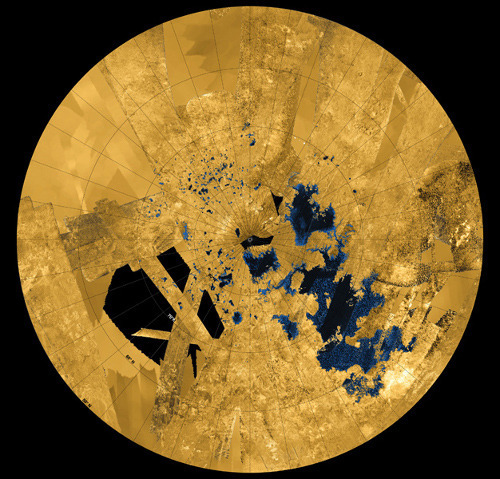
Image: This colorized mosaic from NASA’s Cassini mission shows the most complete view yet of Titan’s northern land of lakes and seas. In this projection, the north pole is at the center. The view extends down to 50 degrees north latitude. In this color scheme, liquids appear blue and black depending on the way the radar bounced off the surface. Land areas appear yellow to white. A haze was added to simulate the Titan atmosphere. Kraken Mare, Titan’s largest sea, is the body in black and blue that sprawls from just below and to the right of the north pole down to the bottom right. Ligeia Mare, Titan’s second largest sea, is a nearly heart-shaped body to the left and above the north pole. Punga Mare is just below the north pole. Credit: JPL.
Note the smaller lakes above and to the left of the north pole, which are about 50 kilometers across or less. Moreover, the new data are finally telling us how deep at least one of the seas is. Because the liquid methane of Ligeia Mare is very pure, Cassini’s radar signal passes through it easily and can detect a signal from the sea floor. The lake turns out to be about 170 meters deep, and in at least one place is deeper than the average depth of Lake Michigan. With northern summer approaching, Titan’s lake country should be entering an interesting meteorological phase for Cassini’s future studies as the atmosphere heats up.






December 16, 2013
Water Vapor Detected Above Europa
Last week’s look at Europa examined the possibility of primordial impacts there that might have brought organic materials to the moon, focusing especially on clay-like minerals that a JPL team found in data from the Galileo mission. I had barely finished that article before the news from Hubble arrived with observations of water vapor above the southern pole of Europa, a possible indication of water plumes erupting from the moon’s surface. That work ran in Science Express and was reported at the meeting of the American Geophysical Union in San Francisco. Lead author Lorenz Roth (Southwest Research Institute) described it this way:
“By far the simplest explanation for this water vapor is that it erupted from plumes on the surface of Europa. If those plumes are connected with the subsurface water ocean we are confident exists under Europa’s crust, then this means that future investigations can directly investigate the chemical makeup of Europa’s potentially habitable environment without drilling through layers of ice. And that is tremendously exciting.”
Exactly so, for now we can start thinking about doing something similar to what has been envisioned at Enceladus, flying a spacecraft through a plume to study what’s below the ice. As the comments on last Thursday’s post (Europa: Minerals from an Ancient Impact) have shown, the question of ice thickness on Europa is wide open, and scientists studying the matter are divided on it — once again I point you to Richard Greenberg’s Unmasking Europa (Copernicus, 2008) for a lively defense of thin ice.
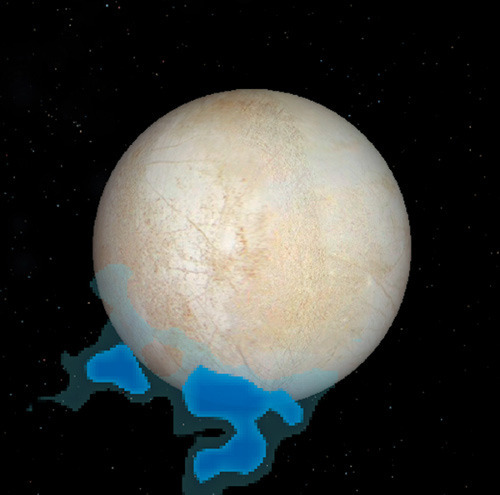
Image: This graphic shows the location of water vapor detected over Europa’s south pole that provides the first strong evidence of water plumes erupting off Europa’s surface, in observations taken by NASA’s Hubble Space Telescope in December 2012. Hubble didn’t photograph plumes, but spectroscopically detected auroral emissions from oxygen and hydrogen. The aurora is powered by Jupiter’s magnetic field. This is only the second moon in the solar system found ejecting water vapor from the frigid surface. The image of Europa is derived from a global surface map generated from combined NASA Voyager and Galileo space probe observations. Credit: NASA, ESA, and L. Roth (Southwest Research Institute and University of Cologne, Germany).
Geysers on Europa could indeed be a signature of a thin ice crust, but as reader Andrew Tribick has noted here, they could also flag a lake enclosed within a thick crust. The key question, of course, is just where the water is coming from. “Do the vents extend down to a subsurface ocean or are the ejecta simply from warmed ice caused by friction stresses near the surface?” Roth asks. So far we don’t know. And as to the source of the faint emissions detected by Hubble, the long cracks on Europa’s surface known as lineae may well be the answer. That would correspond to the fissures that the Cassini spacecraft has seen near the south pole of Enceladus.
But whatever the thickness of Europa’s ice, flying through a plume rather than drilling would make our task immeasurably easier. We can also take up Freeman Dyson’s suggestion, noted in the comments by Larry Klaes, that space around Europa should be investigated for the possible remains of aquatic life forms that could have been blown out by impact events.
Another reminder of Enceladus is the fact that the intensity of the plumes detected on Europa varies with the moon’s orbital position. The jets are detected only when Europa is at the farthest point in its orbit from Jupiter, while signs of venting disappear when the moon is closer. Are we looking at tidal flexing caused by Jupiter’s gravitational pull? That’s what one would expect with a subsurface ocean placed in this environment. It’s interesting that Europa’s own gravity, twelve times that of Enceladus, would cause any water vapor to fall back to the surface, leaving surface features near the south pole that may be observable by future spacecraft.
The paper is Roth et al., “Transient Water Vapor at Europa’s South Pole,” published online in Science 12 December 2013 (abstract).






December 13, 2013
Vessel: A Science Fiction Prototype
Futurist and librarian Heath Rezabek returns with further thoughts on preserving mankind’s heritage through Vessels that would contain everything we are as a species. But in an unusual offering, he goes on to provide a fictional look at how such Vessels affect the future. Just how do we preserve and present Earth’s cultural and biological heritage against events we cannot predict? And if we succeed, what shape will our Vessels take, and who will find them? Join Heath as he ventures into ‘science fiction prototyping’ as a way of influencing outcomes.
by Heath Rezabek

I’ve described The Vessel Project in three prior posts:
August 29, 2013 – Deep Time: The Nature of Existential Risk
October 3, 2013 – Visualizing Vessel
November 7, 2013 – Towards a Vessel Pattern Language
Each month I’ll try to do a new A/B sorting survey on the topic of very long term preservation. Past Poll: “Which positioning / placement of a Vessel archive or haven would take priority?” is continually open for refining votes. (http://www.allourideas.org/vessel-positioning-2013)
Current top three: 1st “Tranquility Base (Moon)”, 2nd “Lunar South Pole”, 3rd “Co-located with the 10,000 year clock (Long Now Foundation)”
This month’s new A/B Sorting Survey is:
Which works depicting cultural, biological, or scientific archival / remembrance / recovery would you recognize as exemplars of their kind? (Books, movie, or any other medium. Please add more…)
(http://www.allourideas.org/precursor-works)
- – -
It is my hope that the ideas explored in this series and in my work will help to inspire others with greater means to make these approaches into realities, as it is truly impossible to undertake such large-scale projects alone. Very long term archival and knowledge preservation seems to me a key step on the path towards an eventual interstellar civilization, and the more we explore all aspects of this journey, the greater our chances of collectively making it.
What can’t be clearly imagined can hardly be achieved. When it comes to creating artifacts that might influence or inspire others, the direct route need not be the only one. Methods such as art and fiction, in particular, can be very powerful in the effort to blaze trails towards possible futures. In this regard, one recent development of great interest to me is that of Design Fiction (sometimes also called Science-Fiction Prototyping).
Design Fiction, briefly discussed in the October 3 entry, can be described as fiction whose primary goal is to paint a picture of the possible, without too much concern for filling in all the details beyond the elements being suggested or explored. Science fiction as a speed-sketch: The goal is to strike sparks, since even small sparks can light the wayfinding torches of others — can inspire and motivate through suspension of disbelief. A recent essay on Design Fiction is useful reading. Bruce Sterling’s “Patently untrue: fleshy defibrillators and synchronised baseball are changing the future” in Wired UK is useful reading in coming to terms with this technique of idea exploration.
My Centauri Dreams contribution this month, then, is a brief detour through the realms of the possible, in an original short piece of design fiction.
- – -
Woven Light (I)

Image: Woven Light (Detail) by Heath Rezabek.
Dust, undisturbed for centuries, billowed as it was brushed aside by alloy digits. In darkness this deep, unaided eyes were blind. Yet the sensors attached to these arms soaked up the bare wisps of light and sound in this place, resolving those streams into a coherent model of surrounding space and time.
Deep set into a dais rested a prism, a cubic matrix tilted and sunken halfway into its setting. Recognizing its target, focal beams pierced the vault and the prismatic cube, splitting and refracting as they traced the edges of frozen memory to recover the data there dreaming. For this slow and steady work, long ago Tracer Aakanthia [9T33] had been conceived.
This particular prism was not the only one, but it was part of a set sharing some unique properties. Among them, the fact that light sent through its channels this way would coalesce into myriad forms above and around it, hanging dimensional in space and rotating in time, glowing softly, changing subtly, as the artifacts encoded here resolved and restored their ancient forms.
In the inky black hung an index, a tapestry of woven light, intricate patterns tracing and retracing, spinning outwards and upwards to mark the collections they mapped. Aakanthia scanned back and forth, both reading and rendering as a holographic memory of New York City (circa 2023) replayed. Compression had eroded some of its infinite edges, but fractal resuggestion was a venerable technique for good reason.
There, suspended like smoke in a sunbeam, unfurled countless moments and relations, each endlessly combining and rejoining. The tracer watched and waited, seeking at the speed of split light for the moment it had triangulated as embedded here. And finding it, slowed time to pause and hover amidst the assembly there gathered at a research lab, long since gone, which had released in prior days the fleets of tiny surveyors that had gathered the data mapped here.
Now, records had suggested, they were poised to release a second fleet, this one bound to double the resolution encoded up to then. Yet there would be a problem, and the second array would not finish its task before other needs intervened. Here, shivering and frozen forms waited for the story to retell itself once more.
The light blinked, and darkness collapsed around Tracer Aakanthia [9T33], its momentary mission complete. Gently lifting the cubic shard, it hovered and drifted back towards an array of its own, a cellular framework of woven carbon splines leading it fore towards the sail sections, slipstreaming starward…

Image: NYC (Fractal Resuggestion) by Heath Rezabek.
- – -
The first Vessel Haven installation ever founded had not been fancy, or even enduring; but at least it had been built. After spending years as a virtual shadow-box of sprawling possibilities suspended in naught but 3D space, seen by few and appreciated by fewer, it had finally been realized, a sort of an imaginary Epcot Center, as (of all things) a theme camp at the Burning Man festival that year.
From without, its most striking feature had also been among its most mundane — simple structural realities had collided with the Vessel habitat’s mission to determine that its outer form was that of a good ol’ geodesic dome. Though once these had been notorious for leakages, advances had changed that; and in any case, the desert was a fairly rain-free place for a mock-up. Advances in the autonomy and resourcefulness of the Replicator Bot had meant that the caliber of trusswork needed to seal and harden the thing at 500 feet in diameter could be achieved: silicate-sourced and fabbed on site.
Its distant bulk and form had seemed a sort of postcard from 1969, oddly comforting and quaint; yet when the notoriously brutal sandstorm of that year finally came, no small number of adventurers ended up finding shelter within its sturdy scope. Thus at last the basic function and mission of a Vessel archive could be transmitted in part and whole to a critical mass of curious minds.
The camp was run in such a way that the business of a Vessel Haven was acted out in small scenes by a vast cast and crew, interspersed with the sheltering crowd. Here you’d look and see what seemed for all the world like a clear cryogenic chamber filled with Indo-Burmese rainforest biomass, in transit to a holding tank; there you’d spy an engineer, smartly sporting a color-coded labcoat, trekking a blinking cube of clearstone circuitry from one node of the Vessel Lattice to another.
At regular intervals, hexagonal worktables hosted scale models and reconstructions of all sorts of things — from a nanoscaled reconstruction of the circular ruins of ancient Rujm el Hiri, to the proverbial kitchen sink (impossibly recovered from Frank Lloyd Wright’s Imperial Hotel) — yet there was nary a taxonomist in sight.
On the outer edges, aproned Learning Lab educators walked the curious through the finer points of a vast mural depicting the Long Now Time Diagram, augmented and expanded and overlaid with projected animations of culture’s machinations bootstrapped through time.
All came to a point here, embodied in one stunning and forward-facing lightsail, its Benford-inspired beamed design hauling a streamlined Voronoi spaceframe, zooming out and back in time to reveal the long meander of the technologies and biophilic designs which had suggested it, planted firmly on a foundation of architectural advances and accidents, interwoven with wood and stone and precious flowing water to reveal the vast work of nature and biology supporting it, and out still further, silt sliding, plates upheaving, until geology blurred with planetary formation and the furnaces of infinity ignited in reverse like campfires in the night. Of course, these were exhibits that would normally be shown to the young, but here the young at heart were well practiced at standing in.
Among those present at the Long Now holomural when the presenter had moved aside to make way for the transport of an autopallette of interlocking twisty-puzzle prisms was 17 year old Aben Ramer. First generation HexaYurt builder and second generation Jungian Surrealist, Aben had come for the Hex Space, hearing that one of the largest complexes of interlaced HexaYurt structures ever conceived had been trussed together here-in.

Image: Hex Space Blueprint by Heath Rezabek.
And this much was true. The basic module, just over 13 feet across but infinitely variable through subdivision of standard 4×8 panels, had finally been iterated into multistory structures some while back; but Aben had never seen anything like the interlocking Çatalhöyük of honeycombed spaces layered here. Circumambular disorientation fades fast for the hex-saavy, but still he was impressed by the care clearly woven into a pattern language that had clarified living centers, promenades, and sheltering spaces for all sizes and sorts of activity as one slowly spiralled inwards towards the staff-only areas.
It was then that one of the crystaloid twisty puzzles fell from the autopallette as it passed him by, landing at Aben’s feet so obviously that he suspected synchronistic dramaturgy. Picking it up, he shook his head at this six-edged mirage, thinking he’d got too much hex on the mind. But then a cube resolved as he turned it, and visually slipped again into what seemed like the form of a flattened hexagonal piezoelectric shard.
“What the hell.” But then, before he could move to execute even a single twist of the subshards around which the puzzle had been designed, he thought of his mother.
His mother, he remembered, was at a workshop in New York City. Aben knew well enough — as well as his mother could tell him — that she was at work on a very long term data storage project. (He wondered then whether that connection, too, had brought him to this Vessel in the storm, though he’d swear he hadn’t been conscious of that overlapping theme before he’d arrived.) She couldn’t say as much about the project’s scope or sponsors as she could about some of its requirements.
The team was struggling with the capacities needed for immersive motion holography. She wanted, she’d said, to preserve not just datapoints but dataflows through time. And she wanted to build a seamless bridge that any sentient being could cross, moving (however long it took) from a simple visual understanding that an artifact embodied signal, to the building of the means to decode that signal, and the finding in that signal of ever deeper construction sets leading all the way down to the digital DNA storage technologies that their holography solution had to hug.
Last month they had released a pod of mappers in Central Park, and he knew this week they were there to analyse the results. But the means to store this signal as portably and fluidly as they’d needed had so far eluded them.
He blinked at the apparition, the amusement, in his hands. Tilting it upwards, he beamed a slim vector of light at the puzzle. As he’d expected, he watched it splay through the prism into myriad forms suspended and projected all about. “It’s full of…”
He twisted a shard and beamed it again. Though the patterns had shifted, their subject was clear. Orion’s belt swung gently before his gaze, and then spun. And spinning, dissolved as something else entirely resolved itself anew. He had never seen a white dwarf this closely before; and indeed it was impossible. Yet here it floated, and here he gazed at this impossible diamond adrift in a dome of sky.
He was pretty sure he had found something, at this temporary “here” in the middle of nowhere; a skeleton key for the work his mother was doing.
It would be generations before the Tracer Guild could confirm that Aben’s hunch had been an astronomical understatement.

Image: Beta Vessel by Joshua Davis.






December 12, 2013
Europa: Minerals from an Ancient Impact?
Europa continues to fascinate those hopeful of finding life elsewhere in our Solar System, and it’s easy to see why. Consider everything the Jovian moon has going for it. Although it’s a long way from the Sun (Jupiter is 5 AU out), Europa gets internal heat from its interactions with the gravitational well around Jupiter, which causes the moon to be stretched and squeezed. We have an ocean whose occasional eruptions into the ice above allow mixing with surface materials and, as this JPL news release points out, salts on the surface that create an energy gradient. These factors have been in place on Europa since the moon first formed.
Now an analysis of data from the Galileo mission has turned up something else needed for life: The likelihood of organic materials. The assumption has been that comet or asteroid impacts could provide these, and the data that Jim Shirley (JPL) will discuss tomorrow at the American Geophysical Union meeting in San Francisco show the presence of clay-type minerals on the moon, assumed to have been delivered by just such a collision. Says Shirley:
“Organic materials, which are important building blocks for life, are often found in comets and primitive asteroids. Finding the rocky residues of this comet crash on Europa’s surface may open up a new chapter in the story of the search for life on Europa.”
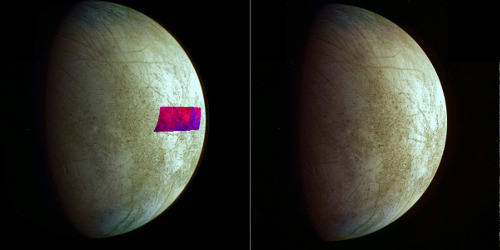
Image: This image, using data from NASA’s Galileo mission, shows the first detection of clay-like minerals on the surface of Jupiter’s moon Europa. The clay-like minerals appear in blue in the false-color patch of data from Galileo’s Near-Infrared Mapping Spectrometer. Surfaces richer in water ice appear in red. The background image is a mosaic of images from Galileo’s Solid State Imaging system in the colors that human eyes would see. A version of the image without the infrared area is on the right. Credit: NASA/JPL.
The pattern of the detected minerals gives us some idea about the impactor that brought them. Shirley’s work suggests an asteroid about 1100 meters across or a comet about 1700 meters in size, either of these striking at a shallow angle. The minerals, called phyllosilicates, showed up in near-infrared images from Galileo, appearing as a broken ring about 40 kilometers wide that is 120 kilometers from the center of a central crater site. We’re probably looking at the backsplash of ejected materials from a strike at an angle of about 45 degrees or more off the vertical — a head-on collision would have vaporized the impactor or driven its materials below the surface.
All this assumes, however, that the organic materials did not come from Europa’s interior in the first place. The JPL news release notes that this is unlikely because of the thickness of the icy crust over Europa’s ocean, assumed to be as much as 100 kilometers thick. But the thickness of that crust is still the cause of some controversy, and for that I turn you to Unmasking Europa: Of Ice and Controversy, which looks at Richard Greenberg’s book on the moon and discusses surface features that may indicate a much thinner crust. What we obviously need to make this call is more information, and that may translate into a Europa mission with lander capabilities.






Paul Gilster's Blog
- Paul Gilster's profile
- 7 followers



